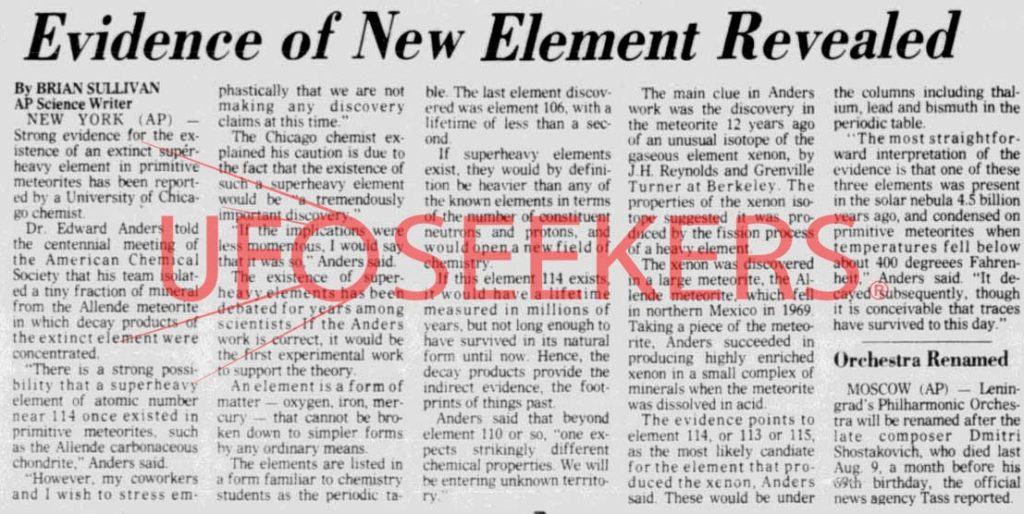Evidence of New Element Revealed
By BRIAN SULLIVAN
AP Science Writer
New York (AP) – Strong evidence for the existence of an extinct superheavy element in primitive meteorites has been reported by a University of Chicago chemist.
Dr. Edwards Anders told the centennial meeting of the American Chemical Society that his team isolated a tiny fraction of mineral from the Allende meteorite in which decay products of the extinct element were concentrated.
“There is a strong possibility that a superheavy element of atomic number near 114 once existed in primitive meteorites, such as the Allende carbonaceous chondrite,” Anders said.
“However my coworkers and I wish to stress emphastically that we are not making any discovery claims at this time.”
The Chicago Chemist explained his caution is due to the fact that the existence of such a superheavy element would be “a tremendously important discovery.”
“If the implications were less momentous, I would say that it was so.” Anders said.
The existence of super heavy elements has been debated for years among scientists. If the Anders work is correct, it would be the first experimental work to support the theory.
An element is a form of matter – oxygen, iron, mercury – that cannot be broken down to simpler forms by an ordinary means.
The elements are listed in a form familiar to chemistry students as the periodic table. The last element discovered was element 106, with a lifetime of less than a second.
If super heavy elements exist, they would by definition be heavier that any of the known elements in terms of the number of constituent neutrons and protons, and would open a new field of chemistry.
If this element 114 exists, it would have a lifetime measured in millions of years, but not long enough to have survived in its natural form until now. Hence, the decay products provide the indirect evidence, the footprint of things past.

Anders said that beyond element 110 or so, “one expects strikingly different chemical properties. We will be entering unknown territory.”
The main clue in the Anders work was the discovery in the meteorite 12 years ago of an unusual isotope of the gaseous element xenon, by J.H. Reynolds and Grenville Turner at Berkeley. The properties of the xenon isotope suggested it was produced by the fission process of a heavy element.
The xenon was discovered in a large meteorite, the Alende meteorite, which fell in northern Mexico in 1969. Taking a piece of the meteorite, Anders succeeded in producing highly enriched xenon in a small complex of minerals when the meteorite was dissolved in acid.
The evidence points to element 114, or 113 or 115, as the most likely candidate for the element that produced the xenon, Anders said. These would be under the columns including thallium, lead and bismuth in the periodic table.
“The most straightforward interpretation of the evidence is that one of these three elements was present in the solar nebula 4.5 billion years ago, and condensed on primitive meteorites when temperatures fell below about 400 degrees Fahrenheit,” Anders said. “It decayed subsequently, though it is conceivable that traces have survived to this day.”
Albuquerque Journal, April 07, 1976

